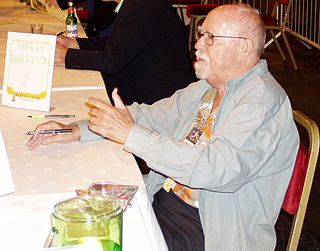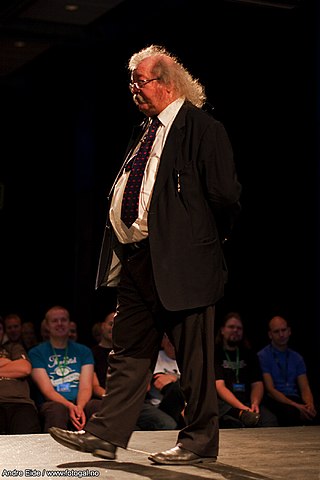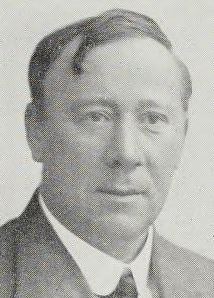Willy Ustad (born 16 May 1946 in Trondheim) is a Norwegian novelist. [1]
Willy Ustad (born 16 May 1946 in Trondheim) is a Norwegian novelist. [1]
Ustad grew up in a heavily forested part of Trøndelag. He was an army employee until he was past 30, and later a metalworker and active union member. Health problems forced him to stop working in the factory, and he started writing full-time.
He is a popular novelist, publishing close to 80 titles published 1989 and 2015. He is a member of the Norwegian Authors' Union. The Union has a literary council. Members must have at least two works judged to have literary value.
Of several series, his most popular is Fire søsken (Four Brothers and Sisters) (42 books). Others are Opprør (Uprising) (about 1960s type radicalism, 7 books) and Vokterne (The Guardians), an X-files-like science fiction series of 6 for young adults.
His books depend heavily on his background, as well as extensive research.
They are often placed in Trøndelag, both in the largest city Trondheim, in smaller industrial cities, the countryside and unpopulated forests and mountain landscapes. They may continue into the large forests of Sweden across the border, or occasionally further, including the Soviet Union, Japan and the United States.
Military and security personnel, industrial workers and working women - often unwed mothers - as well as small farmers and city criminals are among those who populate his books. Most of them have female heroes.
His tales mix historical and social realism with the fantastic in the form of ghost stories, local legends and science fiction. Many have spy themes come from the Cold War. Some are realistic crime stories, some fantasies, several are airplane thrillers (among them a book about the U-2 Crisis of 1960), some are documentary novels about historical themes, while one or two are erotic novels.
Most of his books link with each other through common characters, settings and themes. A novel about the Norwegian prewar detective hero Knut Gribb describes the building of a factory that is important later in Fire Søsken. Characters from that series participate in the series Vokterne. A priest described in a historical novel about the Black Death makes an appearance as a ghost several hundred years later in a Fire søsken novel. In one sense, they might be regarded as parts of a still expanding mega-novel.
One of his early non-series books, Ulvetid (A Time of Wolves) describes the flight of a slave girl during the late Viking age, into a forest where she joins a group of wolves. This is based on a local legend. On her way she passes through a large battle, and she meets the hulder, a supernatural woman that belongs to the subteranians still feared in remote parts of Norway.
The novel was sold in the museum shop at Stiklestad in Trøndelag, that commemorates the Battle of Stiklestad in 1030, where Olaf II of Norway fell. He was later sainted as St. Olav, Norway's patron saint, with a wide cult around the North Sea in catholic times.
Ustad has written a couple of non-fiction books about flying saucers.
Social issues have been the driving force behind many of Ustad's books.
The Fire Søsken series started with the novel Tyskertøs (a derogatory word about girls who went with Germans during the Nazi occupation), about a girl who has an out-of-wedlock baby with a German soldier on the day the war ends in 1945. It tells the story about the persecution of these women during the liberation days, which has been a taboo theme in Norway.
The book set a record as the up to then best-selling first novel in a series, and was made into a radio play for the official Norwegian channel NRK.
The main protagonist in Tyskertøs, Lena Karlsbu and her very diverse brothers and sisters become the heroes (and sometimes antiheroes) of the rest of the series. They became a vehicle that allowed Ustad to excavate several taboo real-life stories in later books. As he continued exploring this in the series, he received death threats from people who thought he was writing about abuse they had been involved in during the 1940s.[ citation needed ]

Philip José Farmer was an American author known for his science fiction and fantasy novels and short stories.

Nidaros Cathedral is a Church of Norway cathedral located in the city of Trondheim in Trøndelag county. It is built over the burial site of King Olav II, who became the patron saint of the nation, and is the traditional location for the consecration of new kings of Norway. It was built over a 230-year period, from 1070 to 1300 when it was substantially completed. However additional work, additions and renovations have continued intermittently since then, including a major reconstruction starting in 1869 and completed in 2001.

Verdal is a municipality in Trøndelag county, Norway. It is part of the Innherad region. The administrative centre of the municipality is the town of Verdalsøra. Some villages in the municipality include Forbregd/Lein, Lysthaugen, Stiklestad, Trones, Vera, Vinne, and Vuku.

Harry Max Harrison was an American science fiction author, known mostly for his character The Stainless Steel Rat and for his novel Make Room! Make Room! (1966). The latter was the rough basis for the motion picture Soylent Green (1973). Long resident in both Ireland and the United Kingdom, Harrison was involved in the foundation of the Irish Science Fiction Association, and was, with Brian Aldiss, co-president of the Birmingham Science Fiction Group.

A romance novel or romantic novel generally refers to a type of genre fiction novel which places its primary focus on the relationship and romantic love between two people, and usually has an "emotionally satisfying and optimistic ending." Precursors include authors of literary fiction, such as Samuel Richardson, Jane Austen, and Charlotte Brontë.

Trøndelag is a county in the central part of Norway. It was created in 1687, then named Trondhjem County ; in 1804 the county was split into Nord-Trøndelag and Sør-Trøndelag by the King of Denmark-Norway, and the counties were reunited in 2018 after a vote of the two counties in 2016.

The Battle of Stiklestad in 1030 is one of the most famous battles in the history of Norway. In this battle, King Olaf II of Norway was killed. During the pontificate of Pope Alexander III, the Roman Catholic Church declared Olaf a saint in 1164.

Falstad concentration camp was situated in the village of Ekne in what was the municipality of Skogn in Norway. It was used mostly for political prisoners from Nazi-occupied territories.

The 1632 series, also known as the 1632-verse or Ring of Fire series, is an alternate history book series and sub-series created, primarily co-written, and coordinated by American author Eric Flint and published by Baen Books.

Stiklestad is a village and parish in the municipality of Verdal in Trøndelag county, Norway. It is located 4 kilometres (2.5 mi) east of the town of Verdalsøra and about 2 kilometres (1.2 mi) southeast of the village of Forbregd/Lein. The village is mainly known as the site of the Battle of Stiklestad on 29 July 1030. Stiklestad Church is located in the village and it is assumed to have been erected on the exact spot where King Olaf II Haraldsson fell in the battle. The king was buried in Nidaros (Trondheim), canonised there on 3 August 1031, and later enshrined in Nidaros Cathedral. Following the Lutheran reformation of 1537 the saint's remains were removed and their precise resting-place has been unknown since 1568.

Thorir Hund was one of the greatest chiefs in Hålogaland. Tore Hund was one of the leaders of the Stiklestad peasant faction opposing Norwegian King Olaf II of Norway, later named St. Olaf. He was reported to have been among the chieftains who killed the king in the Battle of Stiklestad in 1030. He also served in the forces of King Canute the Great on several occasions.
The Norse mythology, preserved in such ancient Icelandic texts as the Poetic Edda, the Prose Edda, and other lays and sagas, was little known outside Scandinavia until the 19th century. With the widespread publication of Norse myths and legends at this time, references to the Norse gods and heroes spread into European literary culture, especially in Scandinavia, Germany, and Britain. In the later 20th century, references to Norse mythology became common in science fiction and fantasy literature, role-playing games, and eventually other cultural products such as Japanese animation. Storytelling was an important aspect of Norse mythology and centuries later, with the rediscovery of the myth, Norse mythology once again relies on the impacts of storytelling to spread its agenda.

Jon Bing was a Norwegian writer and law professor at the Norwegian Research Center for Computers and Law (NRCCL), and the Faculty of Law at the University of Oslo. Bing was considered a pioneer in international IT and information law. He held honorary doctorates from the University of Stockholm and the University of Copenhagen, and was a visiting professor at Kings College, University of London. Bing was part of The Protection of Privacy Committee. From 1979 to 1981 he was head of Norsk Filmråd. Between 1981 and 1982, he was the head of The Council of Europe Committee on Legal Data Processing. Between 1993 and 2000, he headed Norsk kulturråd.

Superhero fiction is a genre of speculative fiction examining the adventures, personalities and ethics of costumed crime fighters known as superheroes, who often possess superhuman powers and battle similarly powered criminals known as supervillains. The genre primarily falls between hard fantasy and soft science fiction in the spectrum of scientific realism. It is most commonly associated with American comic books, though it has expanded into other media through adaptations and original works.

Kristian Kristiansen was a Norwegian novelist, playwright, writer of short stories, and children's writer.

Øvre Richter Frich, full name Gjert Øvre Richter Frich, was a Norwegian reporter, newspaper editor and crime fiction writer. He was one of the most popular writers of crime fiction in Norway during the interwar period.
Richard Edward Wormser was an American writer of pulp fiction, detective fiction, screenplays, and Westerns, some of it written using the pseudonym of Ed Friend. He is estimated to have written 300 short stories, 200 novelettes, 12 books, many screenplays, and stories turned into screenplays, and a cookbook: Southwest Cookery or At Home on the Range.

Sør-Trøndelag was a county comprising the southern portion of the present-day Trøndelag county in Norway. It bordered the old Nord-Trøndelag county as well as the counties of Møre og Romsdal, Oppland, and Hedmark. To the west is the Norwegian Sea, and to the east is Jämtland in Sweden. The county was separated into a northern and southern part by the Trondheimsfjord. Slightly over 200,000 of the county's population lives in the city of Trondheim and its suburbs. The Norwegian dialect of the region is Trøndersk.

Nord-Trøndelag was a county constituting the northern part of the present-day Trøndelag county in Norway. The county was established in 1804 when the old Trondhjems amt was divided into two: Nordre Trondhjems amt and Søndre Trondhjems amt. In 2016, the two county councils voted to merge (back) into a single county on 1 January 2018.

Nirmala Govindarajan is an Indian novelist and journalist. Her novel Taboo (2019) was shortlisted for the Rabindranath Tagore Literary Prize and was longlisted for the Atta Galatta Bangalore Literature Festival Book Prize in 2020.